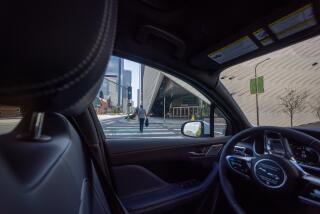Rear cameras top parking sensors in stopping crashes, IIHS says
- Share via
Rear cameras work better than parking sensors at preventing drivers from running over small children or hitting objects while backing up, according to a study by the Insurance Institute for Highway Safety.
The insurance trade organization tested the systems recently with a group of
volunteer drivers in an empty parking lot at the StubHub Center in Carson. The test results indicated that cameras by themselves worked better than sensors and cameras combined at preventing drivers from backing into pedestrians and obstacles.
“Right now cameras appear to be the most promising technology for addressing this particularly tragic type of crash, which frequently claims the lives of young children in the driveways of their own homes,” says David Zuby, the Institute’s executive vice president and chief research officer.
The institute said an estimated 292 people are killed and 18,000 injured each year by drivers who back into them. The collisions typically occur in driveways or parking lots. Children and the elderly are the most frequent victims of such crashes.
The bigger the vehicle, the bigger the risk.
That’s because drivers can’t easily see people and objects low to the ground behind the rear bumper. Sport-utility vehicles and pickup trucks typically have the biggest blind zones and are involved in more back-over collisions than cars, the institute said.
The organization, which researches automotive safety for the insurance industry, studied the driving habits of 111 volunteers using a 2013 Chevrolet Equinox LTZ. It picked the Equinox because it is a popular midsize SUV that in another study was found to have an averaged-sized blind zone. The drivers were told they were testing the SUV’s entertainment and information systems.
At first they were asked to complete parking maneuvers and other tasks such as tuning the radio and reading from a navigation display. They were then asked to back out of a parking spot and drive back to where they parked their personal car. As they backed out, a foam cutout of a child-size crash-test dummy was placed in the SUV’s path.
In some cases, the institute put a stationary dummy behind the vehicle, while in other instances it used a radio-controlled platform to slowly slide the dummy into the SUV’s path from the driver’s side.
Most drivers avoided the moving dummy. The most dangerous situation was when the dummy was stationary.
The proportion of drivers who collided with the stationary object was four times as large as the proportion that collided with the moving object. Drivers with the rearview camera alone had the fewest collisions with the stationary object; 56% of them hit it. In contrast, all the drivers who had no technology hit the stationary object, while parking sensors alone helped just 1 out of 16 drivers avoid a crash.
Automakers are looking at this and other research as they plan new models. Honda, for example, said it will have rearview cameras standard on all Honda and Acura models as of the 2015 model year.
“Rearview cameras are an integral part of Honda’s approach to enhance driver visibility,” said Art St. Cyr, the car company’s vice president of product planning and logistics.
ALSO:
Why Tesla jilted California as site for battery plant
Consumer Reports names Tesla top pick in annual car rankings
Ford and Chevy trucks, Honda Accord most likely to last 200,000 miles







